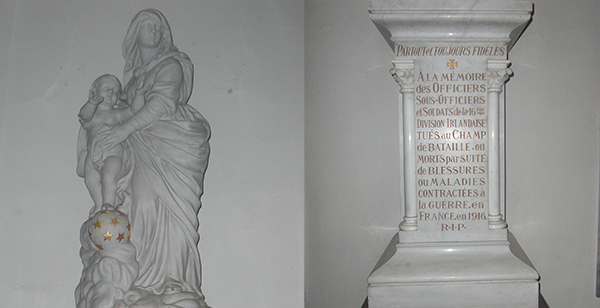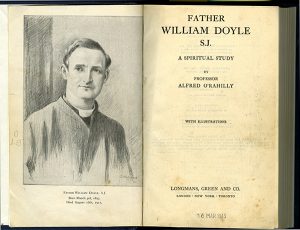ARTEFACTS: Our Lady of Victories, Noeux-les-Mines
Published in Artefacts, Issue 4 (July/August 2016), Volume 24By Seán Downes

Above: Our Lady of Victories, Noeux-les-Mines—the erection of the statue, paid for by subscriptions from the men of the 16th (Irish) Division in 1916, was delayed until 1921. (Christine Hadoux)
During the months that the 16th (Irish) Division was based in the Loos salient, its divisional headquarters were located at the town of Noeux-les-Mines, about five miles from the front line. It was here that the men paraded and were drilled, and it was to Noeux that the Irish often returned to rest and refit after taking their turn in the front lines.

Above: Fr Willie Doyle, one of the 16th (Irish) Division’s chaplains, who organised the subscriptions. (Father William Doyle SJ: a spiritual study, by Prof. Alfred O’Rahilly)
For many of the Catholic Irish soldiers, the church of St Martin would have been a familiar sight between spells in the trenches. One of the 16th’s chaplains, Fr Willie Doyle from Dalkey in south Dublin, often said Mass there for the men before they returned to the front. By all accounts a charismatic and engaging man, he was hugely popular with the soldiers of the division for his bravery and dedication, not least during the infamous gas attacks of 27 and 29 April 1916 when the division was hit hard, suffering many casualties. It was Fr Doyle that General Hickie contacted about commissioning a memorial to the division’s stay in the area, shortly before it was to be redeployed elsewhere. It was decided that this would take the form of ‘a life-size statue of Our Lady of Victories, to be carved in white marble by the best Paris sculptor and erected in the church of Noeux-les-Mines’. It would be paid for by subscription from the ordinary soldiers.
The 16th Division finally left the Loos area in late August 1916 and moved south, to the Somme. The following year, Fr Doyle found himself once again in the area near Noeux and decided to go back to the church of St Martin. What he discovered when he arrived there appalled him. In a letter home, he wrote:
‘When I went into the ruin, I exclaimed, “M. Le Curé, surely you have had fifty shells in here!” “No”, he answered, “only one; the havoc you see is the work of a single shot”.’
On 25 March 1917 the church had received a direct hit from a 15in. armour-piercing shell fired from a German naval gun. As this was designed not to burst on impact but instead to have a delayed explosion, it ‘came through the wall like paper and exploded inside with results impossible to describe’.
The interior of the church had been devastated. The statue commissioned by the 16th Division had survived, however; it had only arrived that morning, having been delayed on its journey from Paris. Minutes before the bomb struck,
‘… the men arrived with the box, and asked the curé where he wished Our Lady of Victories to be erected. As it was only a quarter of an hour before High Mass, he told them to come back later.’
The statue spent the rest of the war in safe-keeping in the nearby town of Bruay-en-Artois, out of range of the guns. In 1921 it was returned to the refurbished church of St Martin in Noeux-les-Mines. It remains there still.
Enquiries: http://arras.catholique.fr/page-20833.html
Seán Downes is an assistant librarian with Dún Laoghaire–Rathdown library service.
















